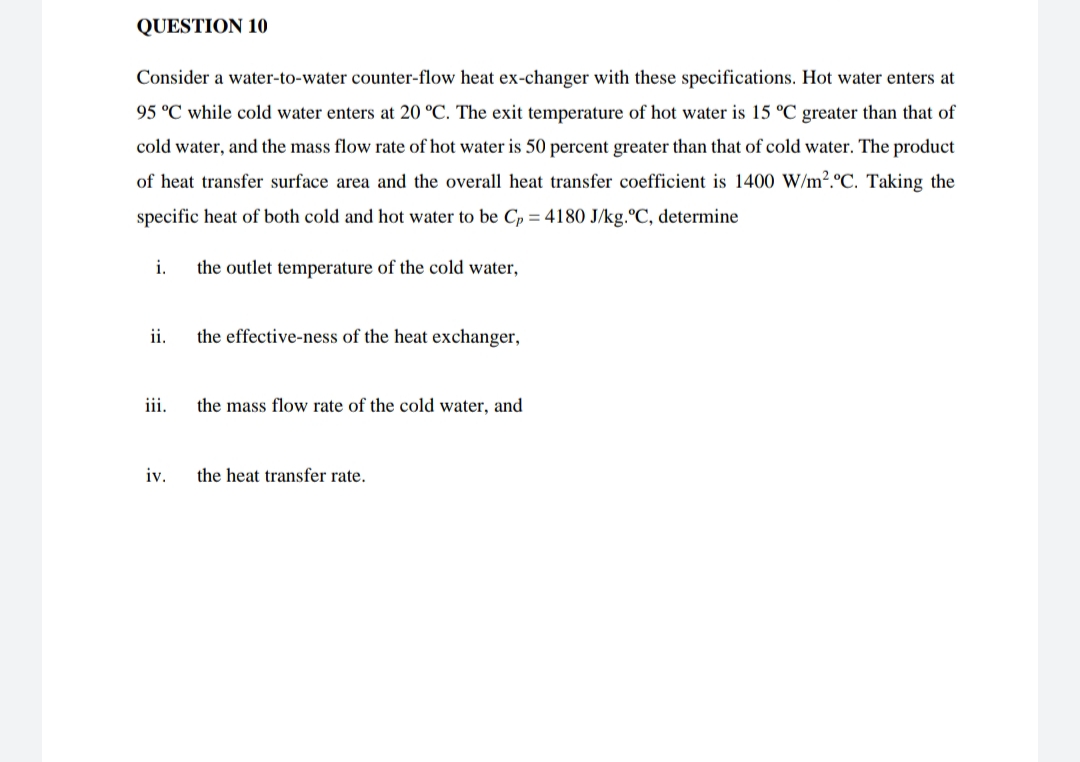Consider a water-to-water counter-flow heat ex-changer with these specifications. Hot water enters at 95 °C while cold water enters at 20 °C. The exit temperature of hot water is 15 °C greater than that of cold water, and the mass flow rate of hot water is 50 percent greater than that of cold water. The product of heat transfer surface area and the overall heat transfer coefficient is 1400 W/m2.°C. Taking the specific heat of both cold and hot water to be C, = 4180 J/kg.ºC, determine i. the outlet temperature of the cold water, ii. the effective-ness of the heat exchanger, iii. the mass flow rate of the cold water, and iv. the heat transfer rate.
Consider a water-to-water counter-flow heat ex-changer with these specifications. Hot water enters at 95 °C while cold water enters at 20 °C. The exit temperature of hot water is 15 °C greater than that of cold water, and the mass flow rate of hot water is 50 percent greater than that of cold water. The product of heat transfer surface area and the overall heat transfer coefficient is 1400 W/m2.°C. Taking the specific heat of both cold and hot water to be C, = 4180 J/kg.ºC, determine i. the outlet temperature of the cold water, ii. the effective-ness of the heat exchanger, iii. the mass flow rate of the cold water, and iv. the heat transfer rate.
Principles of Heat Transfer (Activate Learning with these NEW titles from Engineering!)
8th Edition
ISBN:9781305387102
Author:Kreith, Frank; Manglik, Raj M.
Publisher:Kreith, Frank; Manglik, Raj M.
Chapter7: Forced Convection Inside Tubes And Ducts
Section: Chapter Questions
Problem 7.46P
Related questions
Question

Transcribed Image Text:QUESTION 10
Consider a water-to-water counter-flow heat ex-changer with these specifications. Hot water enters at
95 °C while cold water enters at 20 °C. The exit temperature of hot water is 15 °C greater than that of
cold water, and the mass flow rate of hot water is 50 percent greater than that of cold water. The product
of heat transfer surface area and the overall heat transfer coefficient is 1400 W/m².ºC. Taking the
specific heat of both cold and hot water to be Cp = 4180 J/kg.ºC, determine
i.
the outlet temperature of the cold water,
ii.
the effective-ness of the heat exchanger,
iii.
the mass flow rate of the cold water, and
iv.
the heat transfer rate.
Expert Solution
This question has been solved!
Explore an expertly crafted, step-by-step solution for a thorough understanding of key concepts.
Step by step
Solved in 3 steps with 3 images

Knowledge Booster
Learn more about
Need a deep-dive on the concept behind this application? Look no further. Learn more about this topic, mechanical-engineering and related others by exploring similar questions and additional content below.Recommended textbooks for you

Principles of Heat Transfer (Activate Learning wi…
Mechanical Engineering
ISBN:
9781305387102
Author:
Kreith, Frank; Manglik, Raj M.
Publisher:
Cengage Learning

Principles of Heat Transfer (Activate Learning wi…
Mechanical Engineering
ISBN:
9781305387102
Author:
Kreith, Frank; Manglik, Raj M.
Publisher:
Cengage Learning